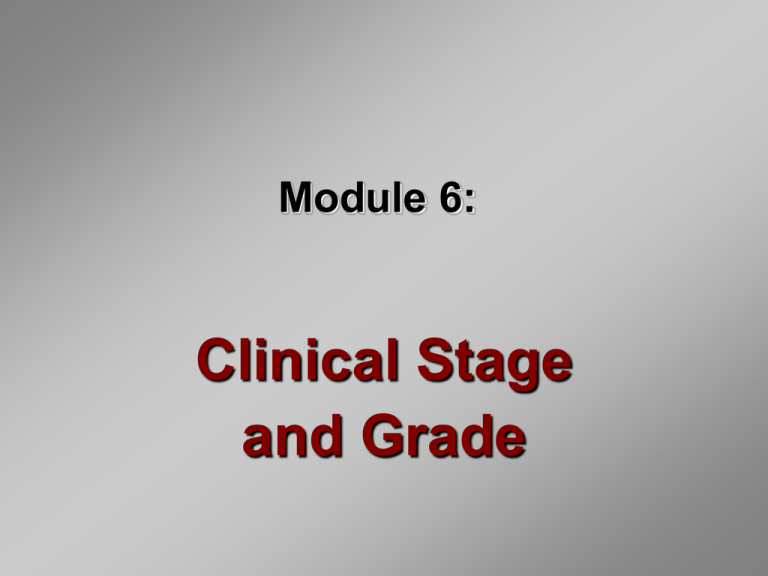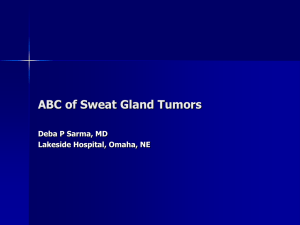Clinical Stage and Grade
advertisement

Module 6: Clinical Stage and Grade Introduction • Stage and grade determine prognosis • Staging reflects the clinical extent of the tumor • Grading a tumor reflects its histologic subtype • Of the two, staging is the primary indicator of prognosis Tumor progression • Tumors may occur spontaneously or follow a series of cellular and tissue changes known as epithelial dysplasia Histologic alterations in epithelial dysplasia • • • • • • • • • Enlarged nuclei and cells Increased nuclear-to-cytoplasmic ratio Hyperchromatic nuclei Pleomorphic (abnormally shaped) nuclei and cells Increased mitotic activity Abnormal mitotic figures Multinucleation of cells Keratin or epithelial pearls Loss of typical epithelial cell cohesiveness Sapp, Eversole, & Wysocki (2004). Contemporary oral and maxillofacial pathology (2nd ed.) St. Louis: Mosby Neville, Damm, & Bouquot (2002). Oral and maxillofacial pathology (2nd ed.) Philadelphia: Saunders Histologic alterations observed in epithelial dysplasia Sapp, Eversole, & Wysocki (2004). Contemporary oral and maxillofacial pathology, 2 nd ed. St. Louis: Mosby, p. 181 Architectural changes in epithelial dysplasia • • • • Bulbous rete pegs Basilar hyperplasia Hypercellularity Altered maturation pattern of keratinocytes Neville, Damm, & Bouquot (2002). Oral and maxillofacial pathology (2 nd ed.) Philadelphia: Saunders Sapp, Eversole, & Wysocki (2004). Contemporary oral and maxillofacial pathology (2 nd ed.) St. Louis: Mosby Carcinoma in situ • When the entire thickness from the basal level to the mucosal surface is affected, the term carcinoma in situ is used • Once dysplastic cells breach the basement membrance and invade the underlying connective tissue, carcinoma in situ becomes squamous cell carcinoma Neville, Damm, & Bouquot (2002). Oral and maxillofacial pathology (2nd ed.) Philadelphia: Saunders Sapp, Eversole, & Wysocki (2004). Contemporary oral and maxillofacial pathology (2nd ed.) St. Louis: Mosby Transition of epithelial dysplasia to invasive squamous cell carcinoma Malignant cells have penetrated through the basement membrane into the underlying connective tissue Sapp, Eversole, & Wysocki (2004). Contemporary oral and maxillofacial pathology, 2 nd ed. St. Louis: Mosby, p. 188 Grading • Degree of differentiation exhibited by cells • How closely cells resemble normal tissue structure • Grade I – low grade • Grade II – moderately differentiated • Grade III – poorly differentiated Neville, B. W., Damm, D. D., Allen, C. M., & Bouquot, J. E. (2002). Oral and maxillofacial pathology (2nd ed.). Philadelphia: W. B. Saunders. Staging • Based upon the size and extent of metastatic spread of the lesion • Tumor-node-metastasis (TNM) system used for most cancers Staging – TNM system • Size, in cm, of the tumor (T) • Involvement of lymph nodes (N) • Presence or absence of distant metastasis (M) Staging – “T” Size of primary tumor (T) in cm TX No information available on primary tumor T0 No evidence of primary tumor Tis Carcinoma in situ at primary site T1 Tumor less than 2 cm T2 Tumor 2-4 cm in diameter T3 Tumor greater than 4 cm T4 Tumor has invaded adjacent structures Staging – “N” Lymph node involvement (N) NX Nodes not assessed N0 No clinically positive nodes (not palpable) N1 Single clinically positive ipsilateral (on same side) node less than 3 cm N2 Single clinically positive ipsilateral node 3 to 6 cm; or Multiple ipsilateral nodes with all less than 6 cm; or bilateral or contralateral nodes with none greater than 6 cm N3 Node or nodes greater than 6 cm Staging – “M” Distant metastasis (M) MX Distant metastasis not assessed M0 No distant metastasis M1 Distant metastasis is present TNM Staging System Stage TNM Classification 0 Tis N0 M0 I T1 N0 M0 II T2 N0 M0 III T3 N0 M0 T1 N1 M0 T2 N1 M0 T3 N1 M0 IV T4 N0 M0 T4 N1 M0 Any T N2 M0 Any T N3 M0 Any T Any N M1 Summary • Stage and grade of tumors indicates prognosis • Treatment plans based upon stage and grade, among other factors • TNM system used with most cancers











